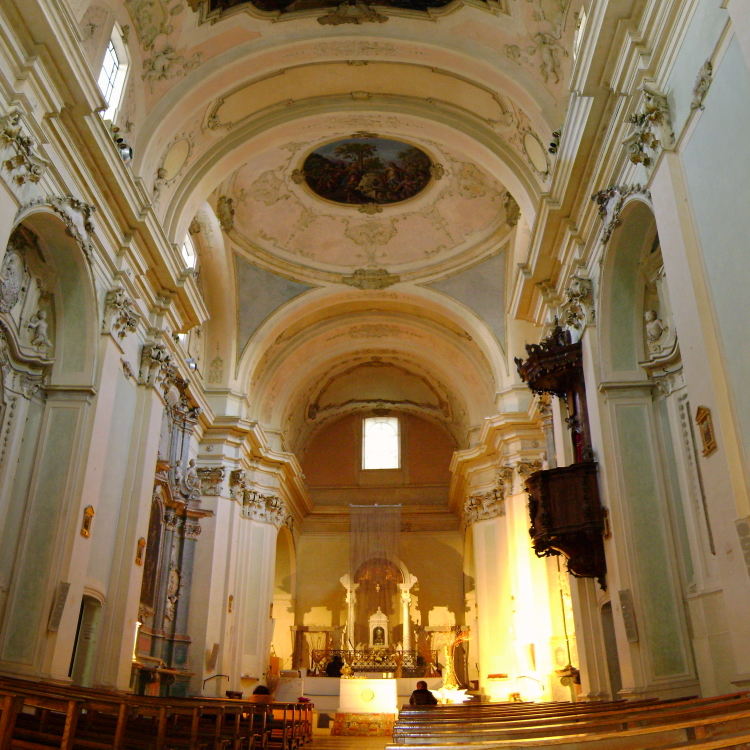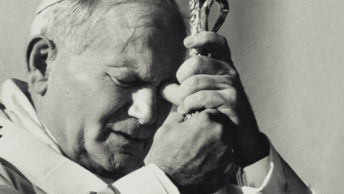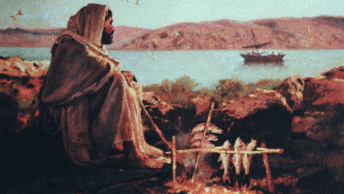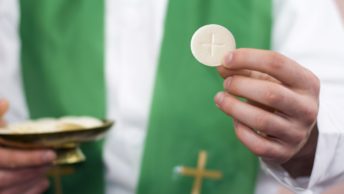The Gospels record for us the story of the Last Supper and those famous words spoken by Jesus, “This is My Body —- This is My Blood.” Those are very powerful words, for they provide us with the opportunity of experiencing the very real and tangible presence of Christ among us even today, 2,000 years after that Last Supper. But I wonder if we truly appreciate the power and the love given to us in those words.
One day in late October in the year 700 A.D., a Basilian Monk was celebrating Mass in a church dedicated to Saints Legontian and Domitian in a town called Lanciano, which is located in southern Italy. During the consecration of the Mass, the Monk was entertaining serious doubts that the wine and unleavened bread in front of him was actually the real and substantial presence of the Body and Blood of Christ. After pronouncing the words of consecration, “This is My Body —– This is My Blood”, the Monk was shocked to see the host in front of him change into, what appeared to be, a real piece of flesh, and the wine change into what looked like real blood. Confused and frightened, the Monk called those in attendance up to the altar to see what had just happened. Needless to say, all were amazed, many tears were reportedly shed, and the news of the event quickly spread throughout the town and eventually all of Italy.
After a few days, the wine which was now blood coagulated and split into five globules of different and irregular shapes and sizes. There has been much speculation, questioning why the number five? Why did it split into five pieces? It is interesting to note that the number five corresponds to the number of wounds Christ suffered on the Cross, the nail wounds in each hand and in each foot and the wound in Christ’s side from the centurion’s lance.
This event, which has become known as the Miracle of Lanciano, is officially recognized by the Roman Catholic Church as a Eucharistic Miracle. This host that became flesh and this wine that became blood can be viewed and venerated even today, for it is contained in a monstrance within that same Church.
Over the years, many tests and investigations have been conducted on these two Sacred Species. The oldest documented test results still in existence are from a test conducted in 1574.[i] In those documents an unexplainable phenomenon was discovered and reported. “The five pellets of coagulated blood are different sizes and shapes. But any combination weighs the same as the total. In other words, 1 weighs the same as 2, 2 weigh the same as 3, and 3 weigh the same as 5.”[ii]
The latest and most impressive investigation was conducted by the scientific community and it took place in 1970 and 1971.[iii] The team conducted their studies over a 15 month period and their testing involved a total of 500 different examinations. Their report was published in 1971.[iv]
The following is a summary of their report:
1) The samples tested were absolutely free of any foreign agents normally used in the preservation of human flesh.
2) The Flesh is real Flesh and the Blood is real Blood.
3) The Flesh and Blood belong to the human species.
4) The Flesh consists of the muscular tissue of the human heart.
5) The Blood was type “AB” positive, characteristic of a man who was born and lived in the Middle East region.
6) Even though the coagulated blood samples were of five different and irregular shapes and sizes, they all proved to be of exactly the same weight.
7) In the Blood there were found proteins in the same normal proportions (percentage-wise) as are found in the sero-proteic make-up of the fresh normal blood.
8) In the Blood there were also found these minerals: chlorides, phosphorus, magnesium, potassium, sodium and calcium.
9) The preservation of the Flesh and of the Blood, which were left in their natural state for over twelve centuries and exposed to the action of atmospheric and biological agents, remains an extraordinary phenomenon.
I would like to emphasize one fact stated in that report. When human blood is left unrefrigerated, the natural physical and chemical properties will break down rapidly through decay. The blood from this Lanciano miracle is over 1,250 years old, yet it still contains all the proteins, chemicals and physical properties of freshly shed blood. Yet these test results state that no preservatives of any kind could be found.
Many miracles, similar to the miracle of Lanciano, have been documented and officially recognized by the Roman Catholic Church as Eucharistic Miracles. This next event that I would like to share with you is the latest reported Eucharistic Miracle. And its similarities to the Lanciano Miracle are both shocking and inspiring.
On August 15, 1996 an elderly Eucharistic minister was distributing communion during Mass in a church named Santa Maria, in Buenos Aires, Argentina. He accidentally dropped a Host. Not sure of what to do, he asked the priest for assistance. The priest reverently picked up the Host and placed it in a small container of water that is traditionally kept next to the Tabernacle for such an event. The priest placed the container in the Tabernacle where, over time, the Host would be expected to dissolve, at which time it could then be disposed of properly.
Six days later the priest examined the container, expecting to find that the Host dissolved. He was confused, however, by what he found. The Host had grown in size and it was covered with red spots or stains. The priest left it in the Tabernacle, thinking that eventually it would dissolve. It was just a matter of sufficient time. But over a period of several more days, the Host changed in appearance to that of coagulated blood, till it eventually looked like a piece of flesh. [v]
A sample of the tissue was sent to a lab in Buenos Aires. The lab reported finding red and white human blood cells and tissue from a human heart. The lab further reported that the tissue sample appeared to still be alive, because the cells were moving or beating as they would in a live human heart.
Three years later, in 1999, Dr. Ricardo Castanon Gomez[vi] was contracted to perform some additional testing. Dr. Gomez sent a sample of the tissue to a lab in New York City. For the purposes of fair and unbiased testing, the lab was not told what the sample was or anything about its origin. The lab reported that the sample received was living muscle tissue from a human heart.
Five years later, in 2004, Dr. Gomez contacted a Dr. Frederick Zugibe[vii] and asked him to evaluate a test sample, again without telling him anything about the sample or its origin. Dr. Zugibe also reported that the sample was that of living muscle tissue from a human heart. The doctor further reported that the muscle tissue appeared to be taken from a person whose heart had been severely traumatized or beaten.
The doctor was then informed of the fact that the sample was obtained in 1996. To which, Dr. Gomez replied, “Then you have to explain one thing to me. If this sample came from a person who was dead, then how could it be that as I was examining it, the cells of the sample were moving and beating? If the heart comes from a person who dies in 1996, how can it still be alive?” Needless to say, the doctor was shocked when he was told the whole story.
Then Doctor Ricardo Castanon Gomez arranged to have the lab reports from the Buenos Aires miracle compared to the lab reports from the Lanciano miracle, again without revealing the origin of the test samples. The experts making the comparison concluded that the two lab reports must have originated from test samples obtained from the same person. They further reported that both samples revealed an “AB” positive blood type. They also said that the DNA report of two test samples were identical. Therefore, the Lanciano sample and the Buenos Aires sample must have been taken from the same person.
There is one more very important and very interesting fact that I must report. When the scientific findings of the blood samples taken from Lanciano and Buenos Aires are compared to those of the scientific team that analyzed the blood samples taken from the Shroud of Turin and from the Sudarium of Oviedo, they are proven to be 100% identical. They are all an “AB” positive blood type. They are all characteristic of a man who was born and lived in the Middle East region.
We will never be able to prove the Christian concept of Transubstantiation to an unbeliever. But Saint Augustine responded forcefully, in the late 4th century, to pagans’ allegations that Christian beliefs were not only superstitious but also barbaric. He points out that science can and should be used to clarify and illuminate the Christian faith.
The examples that I have just cited should help confirm the faith of we, the faithful. These examples should also serve to remind us of the fact that the Eucharistic presence that we see on the altar is much more than just a piece of unleavened bread and glass of wine. That it is actually the Body, Blood, Soul and Divinity of our Lord and Savior Jesus. But most importantly, may we always remember that these miracles that I just cited are not unique. This miracle happens every single day, in every Church throughout the world, at the consecration of the Mass. And with this understanding may we forever treat this Sacred Species with the reverence it deserves.
[i] February 17, 1574 by Bishop Antonio Gaspar Rodrigues
[ii] Book titled “This is My Body, This is My Blood Miracles of the Eucharist1 – Book 1” by Bob & Penny Lord.
[iii] At the initiative of Archbishop Pacifico Perantoni of Lanciano, and of the provincial minister of the Franciscan Conventuals of Abruzzo, and with authorization from Rome, the test was conducted by Doctor Oroardo Linoli, who is a professor of Anatomy and Pathological History and in Chemistry and Clinical Microscopy, and former head of the Laboratory of Pathological Anatomy at the hospital in Arezzo, Italy. He was assisted by Doctor Ruggero Bartelli, a retired professor of human anatomy at the University of Siena.
[iv] Findings presented on March 4, 1971 and Published in Quaderni Sclavo di Diagnostica Clinica e di Laboratori.
[v] Summary of information gathered from Dr. Ricardo Castanon of Mexico City and Father Jeffrey Montz Parochial Vicar at Saint Francis of Assisi, New Orleans.
[vi] Ricardo Castañón Gómez is president of the Grupo Internacional Para la Paz (International Group for Peace). Based in Bolivia, Castañón Gómez’s home country, and also operating out of the other members’ 12 countries, the nonprofit group is a collection of self-financed research professionals who investigate mystical phenomena. They report their results, as scientific opinion, directly to the Vatican for consideration. Ricardo Castañón Gómez is a clinical psychologist specializing in brain biochemistry, has participated in more than half a dozen studies of Eucharistic miracles over the past two decades.
[vii] Dr. Frederick Zugibe is a forensic pathologist.








